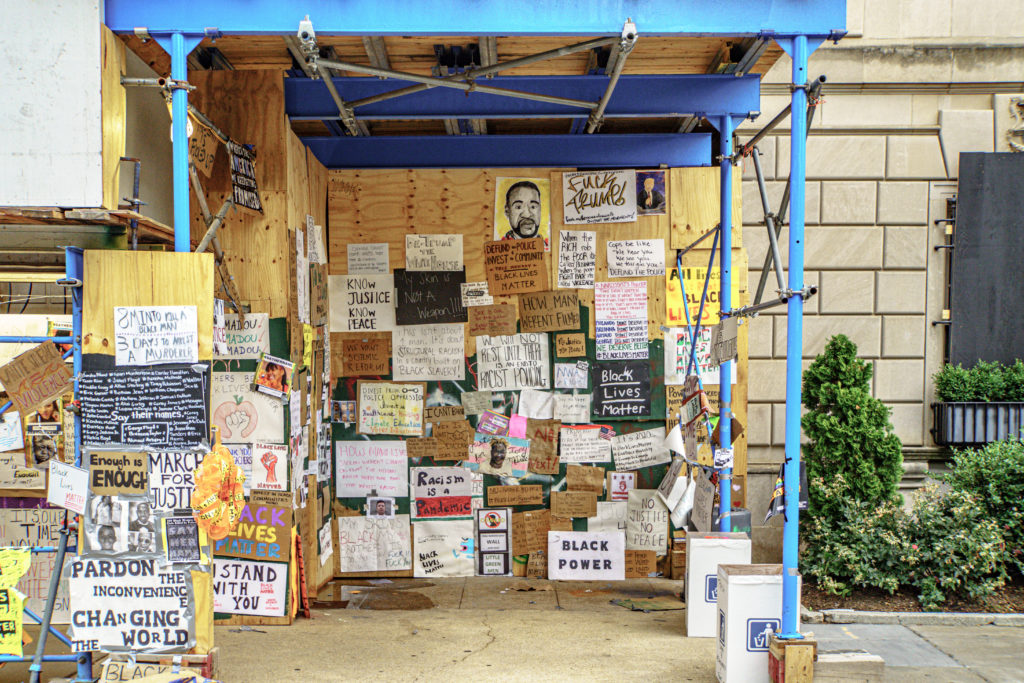Two Night Circus Summary: “Making a Monument: Documenting a Washington, D.C. Black Lives Matter Protest Wall in 2020”
Online Webinar via Zoom
Attendance: 113

During the first night of WCG’s Two Night Circus, a pre-program student presented their independently driven project documenting a Black Lives Matter Memorial in Washington, D.C. in the wake of George Floyd’s murder.
In response to the Floyd protest momentum, the National Parks Service and Secret Service erected a fence around The White House and Lafayette Square. During the many marches in D.C., Black Lives Matter activists mounted their protest posters on the fence, which became the basis for the Memorial. Over time, the Memorial was partially dismantled and eventually relocated to a second location near Constitution Ave NW and H street. The Memorial continues to stand with waves of change as posters are mounted up and stripped down.
The presenter grappled with the questions of their own bias in documenting this work and how it can help exalt the voices of the community. They began reflecting on their own partiality and acknowledges that their work has given him comfort during the chaos of 2020.
The Black Lives Matter Memorial was documented using DSLR photography, 360° photography, and photogrammetry. The presenter has taken thousands of photographs over time to capture multiple iterations of the memorial. Capturing 360° photography using an Insta360 One X Camera lays the groundwork for a potential virtual reality rendering. The presenter also worked with CyArk’s “Map the Moment” project to collect and process 3D data to document the physical manifestations of the struggles against racial injustice. CyArk provided a one-hour virtual training for volunteers across the country with instructions on how to capture 3D data, processed the photos taken to make a 3D model, and gave the model ownership to the photographer.
With the support of local institutions, the presenter has access to many resources with respect to equipment and software. As an independent project, the ability to own, capture, process, and store data gives the presenter the freedom to experiment with different models of documentation. They hope to start a digital monument and/or a digital archive for this work.
Without the presenter’s personal investment in this memorial, this extensive documentation would not exist. They hope to create “proof of concepts” for the 3D models with interactive elements, considerations for distribution methods and access, and connect with the Guardians of the memorial to discuss a plan to move forward.
For more information, visit CyArk’s “Map the Moment” Project.
Here are recommendations on how to help with the Black Lives Matter movement and the Black Lives Matter Memorial:
- Show Up
- Donate: www.gofundme.com/f/protect-the-fence
- Call your representatives
- Listen to local organizers
Image caption: Image courtesy of Ted Eytan, 2020.06.19 Black Lives Matter Plaza, Washington, DC USA 171 41226; (Creative Commons License)
https://commons.wikimedia.org/wiki/File:2020.06.19_Black_Lives_Matter_Plaza,Washington, DC_USA_171_41226_(50028465913).jpg
WCG MEETING SUMMARY
By: Anita Dey, Graduate Paper Intern at the Smithsonian Museum of Asian Art, Third Year Graduate Student at the Buffalo State Garman Art Conservation Department.